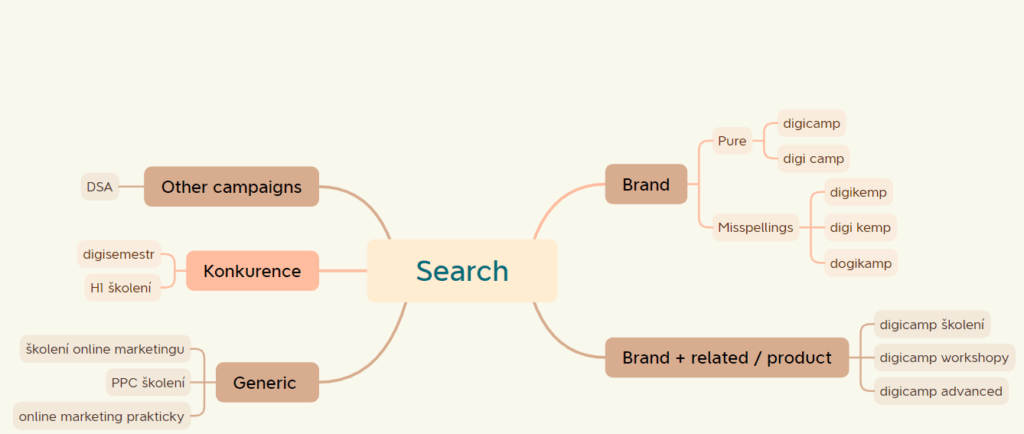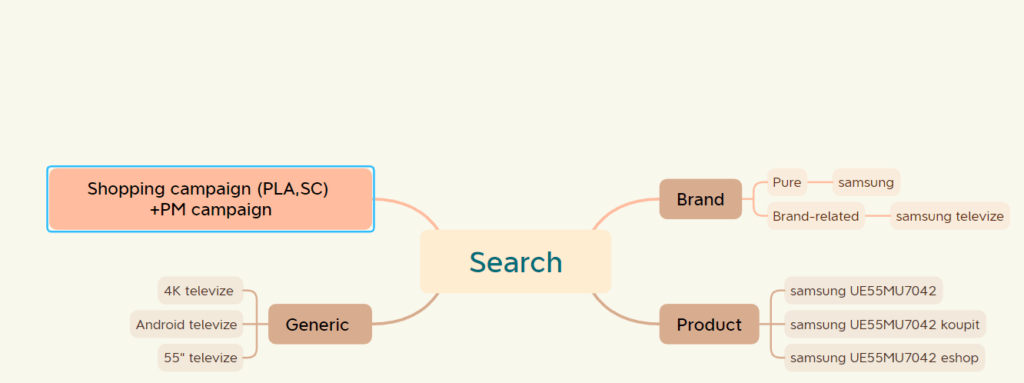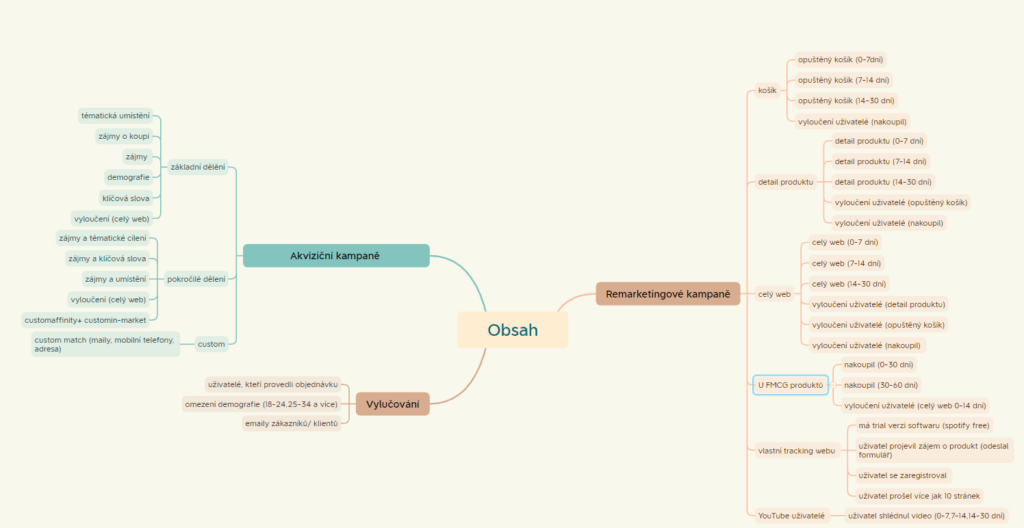We have attended the PPC advanced course
At the end of June and the beginning of July, a PPC advanced course was held at Digicamp s.ro., which was attended by our colleague Bára and 9 other participants. The course was divided into 4 days and the meeting place was Rosmarin Business Center, located in Holešovice. Each part of the course was filled with important and interesting information and real examples from practice.
1.day
At the beginning of the course, the participants reviewed how to find suitable keywords and what types of keywords - matches - exist. Most of the participants answered that they use the keyword planner in Google Ads or Sklik to search for keywords, while looking at competitors' websites. The organizers also recommended that everyone should look at Google Analytics data, specifically organic, site search, and top selling products, when selecting words for a PPC specialist. Paid tools were also mentioned for example Marketing Miner, keywordtool.io, semor.cz, kwfinder.com.
The organizers were also interested in the consistency in which participants used keywords. The most frequent answer was "I use words in phrase and exact match". One of the organizers nodded in response, adding that he also uses phrase and exact match when it comes to search campaigns, and if he has a campaign with the goal of maximizing conversions, he will use keywords in a free match. He then asked his colleague what types of matches he uses. He replied that he mostly uses exact and free match keywords. He also mentioned that when he creates a campaign that will include free match keywords, he also prepares a list of negative keywords to exclude in advance. Most participants tended to agree with the first organizer's opinion. This is because it's a safer option to not exhaust your monthly budget with small clients through clicks on inappropriate words. The second organiser responded to this and explained to the participants that he works with large clients where he has a large budget, hence he has room for some spending and also added that he checks his campaigns every other day to sort out negative keywords regularly. Thus, everyone was advised to act on their own discretion as to which option is most suitable and effective.
How to choose the best campaign structure
The next topic was how to choose the best structure for campaigns. To this question, the organisers responded that they choose the campaign structure according to the strategy/objectives. It is important to be clear on what the goal will be, whether it is visibility of the campaign to increase product awareness, conversion, ROI or traffic i.e. traffic acquisition, getting as many visits as possible for as little money as possible. The organizers still advised everyone to divide the monthly budget into 70%, 20%, 10%, with 70% of the budget being invested in performance campaigns, 20% in traffic or visibility campaigns and 10% for testing.
Additionally, attendees were presented with options for breaking down search and content campaigns, which can be viewed below.

During the explanation, the organizers described an interesting case where an unnamed company, when creating a search campaign targeting a competitor, used the word sconto in the advert, taken from the company name Sconto Furniture. They incorporated the word sconto into the advert in a very clever way, in the following way: 'Sconto means discount in Italian'. In this way they did not infringe any rights and at the same time ensured good visibility of the advertisement.

When creating the remarketing campaigns, the organisers also suggested creating a remarketing campaign for products that the customer will need again in the future, for example contact lenses that have a 30-day usage period. Therefore, ideally, a remarketing campaign should be created to remind the customer preferably a week before the contact lenses expire and can also add a discount for the customer when they purchase again.

Google Ads Editor
In the last part of Session 1, the agenda was to introduce the Google Ads Editor. This is an offline tool that makes working with campaigns easier. One of the organizers then demonstrated in practice how to work with this tool and what all can be done in the program. Participants also had the opportunity to work together with the organizer or to see and try the tool in the comfort of their own home.
2.day
Smart bidding
In this part of the course, the agenda was to introduce participants to Smart Bidding strategies or smart bids. In Google Ads, the PPC specialist has a choice of these smart bids:
- tROAS (return on funds invested in advertising) - this strategy addresses how much to earn and is measured only in eshops, can be used in search, display and shopping campaigns
- target CPA - this smart bid sets what price to spend per conversion. The system itself raises and lowers prices to deliver conversions at a certain value. Target CPA is worthwhile for B2B jobs where revenue per deal is high.
- Conversion maximization (ideal strategy when budget is limited, can be used in search, display and youtube campaigns) When choosing a conversion maximization strategy, the Google Ads user must check that they have the correct primary goal to measure the right type of conversion action. This strategy uses machine learning and is constantly updated.
- eCPC (maximizes the effectiveness of manual bidding and can be used in search, display and shopping campaigns)
The organizers also mentioned practical tips. Rather, they recommended using looser matches for keywords, having multiple variations of ad text and trying experiments.
After creating a campaign with a smart strategy, the learning phase begins. During this period, which lasts about 2 weeks, the campaign is not intervened. After the learning period, there is a testing and subsequent evaluation phase. If a PPC specialist wants to evaluate how many total conversions she has made, it is recommended to look at the campaign after a month of running, due to the delayed/back logging of conversions in Google Ads.
The organizers gave an example of a client who would like to measure ROAS value but does not have an ecommerce store. In this case, the PPC specialist would first establish micro-conversions through leads. These leads can be, for example, phone numbers, forms on the site, email fills. Next, the values of these microconversions are determined. The values are set according to the importance of the lead, for example, calling a phone number will have a value of 200,- and filling out an email 100,-. Then a strategy for maximizing the conversions can be set. These are such imaginary values, which the system can work with and thanks to which the tROAS strategy can then be triggered.
3. day
Performance Max campaigns
The organizers decided to dedicate the beginning of the course to Performance Max campaigns. It was explained to the participants that this is the most advanced type of all in one campaign that appears everywhere. The structure of the campaign consists of groups of documents, records and audience signals. The organizers advised to fill in everything when creating a campaign and try to get excellent ad ratings. For groups of backgrounds, it is better to have more backgrounds of calmly worse quality than fewer backgrounds of better quality. Interestingly, when asked who had created PM campaigns in the past, none of the participants came forward except our colleague Bára.
Afterwards, one of the organizers demonstrated how to set up a PM campaign in practice and as a voluntary homework asked the participants to try to create one at home.
Remarketing
The organizers raised the question of who has remarketing set up. In response to this question, participants said that they mostly use banners and responsive advertising in content networks. Remarketing in search was also mentioned. The organisers then gave the example that it is not ideal to target banner advertising to people who have watched a video ad on YouTube, due to the fact that YouTube targeting is very generic and therefore there is not much chance that the products will attract the right group of potential customers.
Evaluation in GA4
When evaluating, according to the organizers, remember that sales and transactions are evaluated from Google Analytics because of the actual number of orders. For this, it is good to mention that data from Google Analytics will never be accurate as they work with data modelling. Participants were also reminded when and what system counts conversions. In Google Ads, conversions are counted backwards i.e. on the day the user clicked on the ad. In Sklik, on the other hand, the conversion is counted on the day the conversion actually took place.
The organizers also explained the differences between the original Universal Analytics and Google Analytics 4. The original data model was session based and now GA4 is event based. These events record any interaction on the site. GA4 are still in the development phase. The organizers themselves confided that for now, they preferred the original version.
4. day
On the last day, the organizers gave participants the choice to vote on topics that would interest them.
Campaign planning and reporting
When planning campaigns, it is important to start by finding out what the client sells or offers, what location they are in, and targeting a specific area or, in the case of an e-shop, the entire territory accordingly. The Atlas of Czechs portal can help to determine the target group. Next, the monthly budget from the client is determined. It is recommended to start with a search ad, a shopping campaign in case of an eshop and also add content campaigns for remarketing and acquisition. The organizers added, if one wants to increase the credibility of the website and promote brand building, it is advisable to build social media communication in the form of organic posts.
Then the media plan was presented to the participants. The aim of the media plan is to design the different channels into months and estimate their contribution and performance. The organizers also followed up on the topic of reporting. They showed examples of reporting for a small and large client to give participants an idea of creating reporting. They also asked the participants how they create reports. One participant's opinion was that his small clients just need to know how many conversions or clicks they have, but that they are not interested in more detail. Another participant commented that they do the reporting weekly, while adding that they just deliver the reporting to the client after a month, for larger clients they have created an excel spreadsheet that is linked to Google Analytics so the client has an up-to-date view of what is happening on the account.
There is a tool called Looker Studio for creating charts and tables. In this tool, the organisers have created a reporting template that participants can download and create their own report.
This concluded the PPC Advanced course. The organizers also offered the participants the possibility to contact them at any time in case of any uncertainties or questions about a specific issue that was not discussed during the course.
Triton IT s.r.o. is very satisfied with the course and the style of information delivery and definitely recommends this course to anyone interested in expanding their knowledge in the world of online marketing.